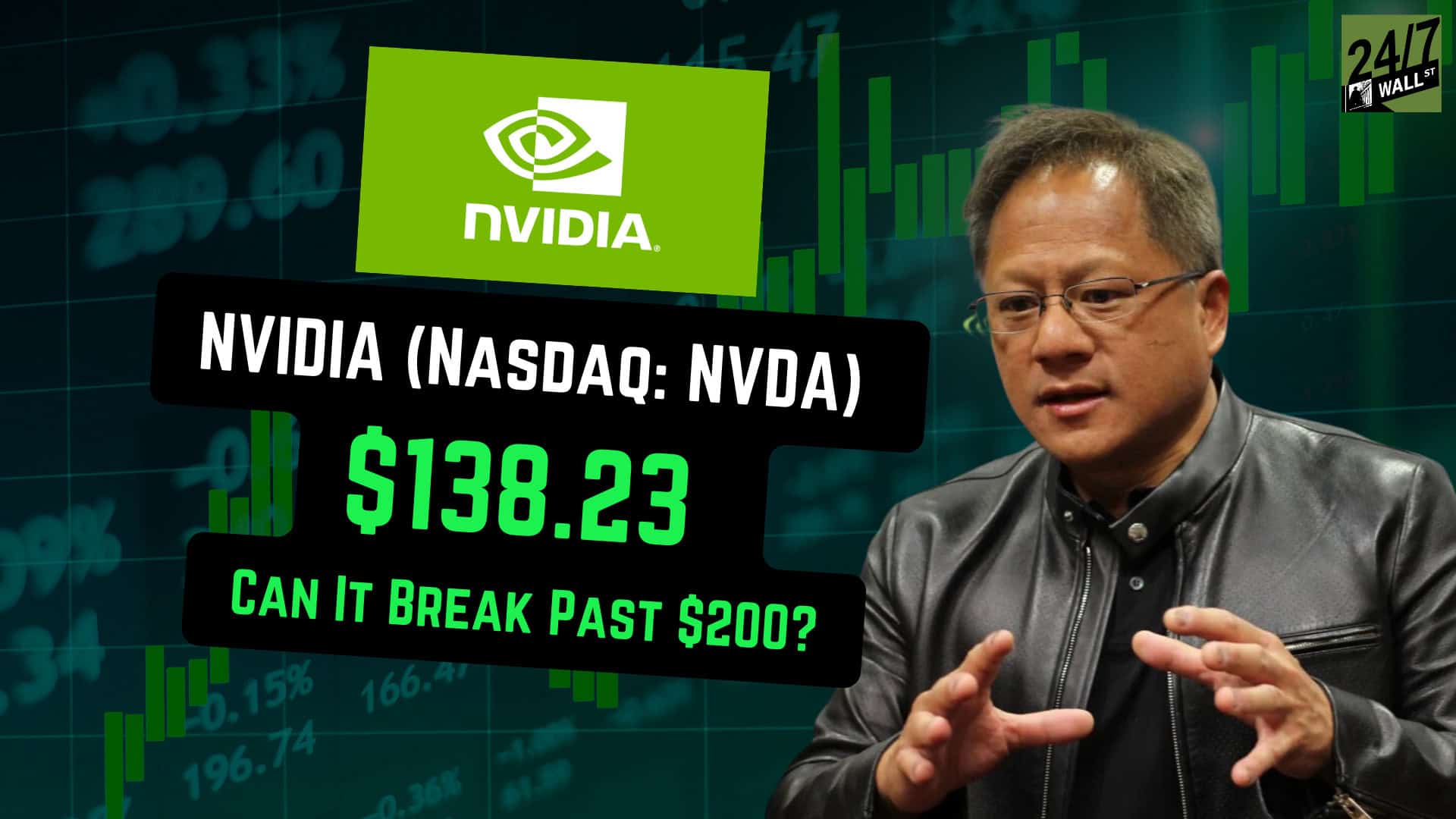
Is NVIDIA (Nasdaq: NVDA) on track to hit $200 per share? In the most recent episode of ‘The AI Investor Podcast,’ we answered a listener question about what it would take for NVIDIA to hit $200 per share.
Key Points in This Article
- Wall Street is still predicting slightly more than $4 in earnings per share from NVIDIA in calendar 2025, but analysts are now racing to increase their earnings estimates for next year as NVIDIA signals demand for their next-generation Blackwell systems is ‘intense.’
- We announced our intent to purchase shares of NVIDIA in our $500,000 AI portfolio on September 12th when NVIDIA was trading for less than $120 per share. Our belief was that NVIDIA would rally as Wall Street was forced to raise earnings estimates for 2025.
- If you’re looking for the most in-depth research report you’ll find on stocks riding the AI boom, grab a free copy of our report named ‘The Next NVIDIA.’ It details why NVIDIA has dominated the first wave of AI and reveals stocks we believe can be massive winners (including a stock with 10X potential) in the next wave of AI growth.
Watch Our Segment on How NVIDIA Can Hit $200 Per Share
3 Catalysts that Have Sent NVIDIA’s Shares Higher in Recent Weeks
On the most recent episode of the AI Investor Podcast, we answered a question from listener Stephen that asked:
“You bought the most of NVIDIA in your first purchases. I see it continuing to gain up to $135 and don’t know if I see the upside from here.
What am I missing? Is NVIDIA capped at $150? Is $200 realistic? Thanks for the show”
As Stephen alludes to, we launched a $500,000 AI Portfolio where we invest in our highest conviction AI stocks and make each stock we buy and amount public. If you’re not familiar with our AI portfolio, you can read more about it.
In our first series of buys, we added $25,000 to NVIDIA (a 5% allocation) under the belief that Wall Street was still underestimating the company’s earnings in 2025 and long-term competitive advantages.
Across the past week, there have been a number of news events that are positive for NVIDIA and have led to a broad rally in NVIDIA shares.
- Blackwell Demand: NVIDIA shared with Morgan Stanley that they’re sold out of Blackwell systems through the end of 2025. That means that NVIDIA’s revenue in the next 12 months won’t be limited by demand, but rather by how many Blackwell systems and chips it can make.
- Rising Wall Street Estimates: Morgan Stanley also issued a research note that NVIDIA’s Blackwell revenue could surpass revenue from its prior generation Hopper chips by the first quarter of next year. One of the recent anchors on NVIDIA’s share price has been worries their ramping of Blackwell could be delayed, which could lead to lower revenue in 2025 and an opportunity for competitors to take market share. With Blackwell on track, Jeffries is now estimating that NVIDIA data center revenue could surpass $210 billion next year. Estimates of that size would likely mean NVIDIA generates more than $5 in earnings per share next year, which is significantly above current Wall Street estimates.
- No Meaningful Market Share Losses: NVIDIA releasing Blackwell chips after only a slight delay also means the company should continue seeing dominant market share (likely in the 85% market share range) in 2025.
The Math Behind NVIDIA According to Wall Street Today

So, given all the catalysts above, can NVIDIA hit $200 per share in the next couple years?
By dividing NVIDIA’s 2025 earnings per share (EPS) by its share price, you can compare how NVIDIA’s valued relative to peers and the broader market.
Here’s How NVIDIA looks at Wall Street’s current estimates for the company (a bit more than $4 in projected EPS next year).
- At $200: NVIDIA would trade for 50X next year’s earnings
- At $150: NVIDIA would trade for 37X next year’s earnings
As you can see, NVIDIA looks fairly expensive in these scenarios. The forward earnings multiple for the S&P 500 is about 23X. Among other big tech peers, here are what forward earnings for 2025 look like:
- Amazon (Nasdaq: AMZN): 31X next year’s earnings
- Apple (Nasdaq: AAPL): 31X next year’s earnings
- Meta Platforms (Nasdaq: META): 24X next year’s earnings
- Microsoft (Nasdaq: MSFT): 30X next year’s earnings
- Alphabet (Nasdaq: GOOGL): 19X next year’s earnings
- Broadcom (Nasdaq: AVGO): 28X next year’s earnings
So, at $150 per share (near the $138 per share NVIDIA trades for today), the company looks a bit more expensive than other big tech peers if you use current Wall Street estimates. However, you could also argue NVIDIA deserves a premium based on recent growth.
The bottom line is you can make a case for NVIDIA at $150 or above at current Wall Street estimates, but it’s a fairly shaky case.
NVIDIA Can Hit $200 If It Delivers on Strong 2025 Growth
But, what if NVIDIA delivers significantly stronger growth next year than Wall Street currently expects?
When we recommended buying shares of NVIDIA on September 12th, it was under the idea that NVIDIA’s growth was underestimated by Wall Street and the company could hit $5 or more in earnings next year.
My estimates for NVIDIA’s earnings if the company can deliver $210 billion in data center sales next year (versus current Wall Street estimates of $170 to $180 billion) lead to NVIDIA getting about $5.15 in earnings per share next year.
If NVIDIA’s earnings grow to that level, here’s what its valuation looks like next year:
- At $200 and $5.15 in 2025 Earnings: 38X next year’s earnings
- At $150 and $5.15 in 2025 Earnings: 29X next year’s earnings
As you can see, if NVIDIA delivers on earnings I believe are much more likely than current Wall Street estimates, at $150 per share it would trade for a cheaper multiple than stocks like Amazon, Apple, and Microsoft do today.
Then there’s the potential for NVIDIA to really outperform and receive something closer to $5.50 in EPS next year. Under that scenario, it would trade for about 36X next year’s earnings. That would be ‘expensive’ for a stock its size, but you can see how it starts moving NVIDIA’s earnings multiple at $200 per share close to in line with its other technology peers.
Regardless, we hope this answers Stephen’s question. NVIDIA won’t be a stock that can repeat massive gains the size it saw in recent years, but even at $140 per share it looks reasonably valued and has more upside if it delivers on the earnings growth we believe is likely next year.
We’re happy to continue holding NVIDIA as our largest holding in our $500,000 AI Portfolio.
More NVIDIA Analysis on ‘The AI Investor Podcast’
We release new episodes of the ‘AI Investor Podcast’ biweekly and are constantly analyzing how new trends impact the company. You can find embeds for our latest episode from both Apple Podcasts and Spotify below.
Apple Podcasts
Spotify Podcasts
Episodes also release to our YouTube channel if you prefer getting notifications there.
Thank you for reading! Have some feedback for us?
Contact the 24/7 Wall St. editorial team.





